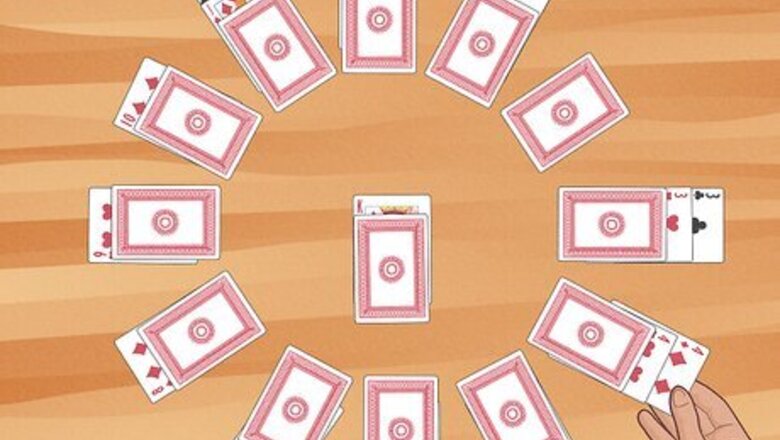
views
Clock Solitaire

Clock Solitaire is an easy game that’s perfect for younger kids. The goal of Clock Solitaire (also called Clock Patience) is to make 4-of-a-kind piles at each of the spaces on the clock’s “face” before all 4 Kings are face up. Deal the cards face down into 13 piles. Arrange 12 of the piles in a circle, with each pile corresponding to a number on the clock’s face. Position the thirteenth pile in the middle of the circle and flip the top card face up. Place the face-up card on the bottom of the pile at the number on the clock’s face that corresponds with the number on the card. For example, the 3 of Hearts belongs at the bottom of the 3 o’clock pile. Treat Jacks as 11, Queens as 12, and Kings as 13. Flip the top card of the pile you just placed the card under. In the above example, with the 3 of Hearts, you would flip the top card of the 3 o’clock pile. Continue to flip and move cards. If you flip a card that belongs in the same pile, place it face up at the bottom of the pile and then flip the next card. You win Clock Solitaire when you’ve flipped all the cards and sorted them into piles of 4-of-a-kind. If, at any point in the game, all 4 kings are face up, you lose.
Pyramid Solitaire
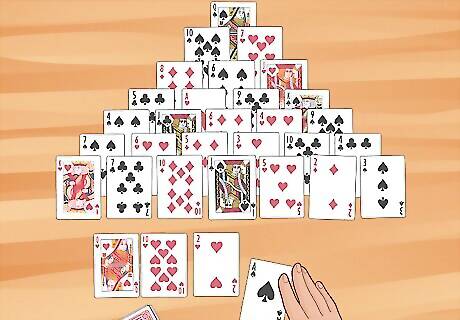
Play Pyramid Solitaire when you want a moderately difficult game. This game takes up a lot of space with its pyramid layout, so it’s not great if you’re short on elbow room. The goal is to remove all of the cards from the pyramid or draw pile. Shuffle the cards thoroughly, and then deal them face up in the shape of a pyramid Start with 1 at the top, 2 in the next row, etc., until you get to a row of 7 cards, overlapping so the row of 7 cards is available for play. Place the leftover cards face down in a pile. This is your draw pile. Remove any 2 exposed cards that add up to 13. Treat Jacks as 11, Queens as 12, and Kings as 13. You don’t need to pair Kings with another card to remove them from the pyramid. Set pairs off to the side. When no two cards add up to 13, draw 1 card from the draw pile. If you can’t play that card, draw the next until you have 2 cards that add up to 13. Alternately, you can draw 3 cards from the draw pile at a time, only playing the top card. When you have flipped all the cards in the draw pile, you can turn them face down and start over again. If you haven’t cleared the pyramid after the third pass through the draw pile, you lose. To win, clear all the cards in the pyramid or the draw pile.
Beleaguered Castle
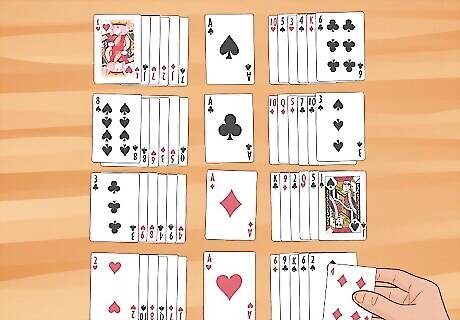
Beleaguered Castle is a relatively difficult game inspired by medieval sieges. The goal is to move all of the cards to the foundation of your “castle.” Remove all 4 Aces from the deck and place them in a vertical column. This is your castle’s foundation. Shuffle the rest of the deck. Deal the cards face up with rows of 6 cards on both sides of each of the aces. Overlap the cards in these rows, with the top card being the farthest from the ace. Build on the foundation Aces in ascending order from 2 to King using only the cards at the ends of rows. If there are no available plays, move the top card from any row to any other row with an available card that’s 1 rank higher in any suit. For example, a 9 of Hearts at the end of 1 row can be moved to any 10 at the ends of the other rows. You may only move 1 card at a time. Once you move cards to the foundation Aces, you can’t move them back to the stacks. If you clear a row, you can move any card to the empty space. When all the foundations have been built from Ace to King, you win!
Forty Thieves

Choose Forty Thieves when you’re ready for a challenge. This game is harder than others because uses 2 full 52-card decks. The goal of the game is to build 8 stacks from Ace to King without mixing suits. Deal 40 cards into 10 columns of 4 cards each. Place the rest of the cards face down to use as a draw pile. Move any available Aces into a row. These are your foundations. You can only move the top card from each column. Once you create a foundation, you can move any available card that’s 1 rank higher in the same suit as the available foundation card. If there aren’t any available Aces or cards to move to the foundations, you may move any available card from 1 column to another as long as it is 1 rank lower in the same suit. Take a card from the draw pile at any time. You can move cards from the draw pile to a foundation pile or any column as long as it’s in the same suit and fits the pattern. If you don’t have any available moves, place the card face-up in the discard pile. Once you’ve played or discarded all of the cards in the draw pile, flip the discard pile face down and start again. When you empty a column, you can move any card to that space. To win the game, you must build all 8 foundations from Ace to King in the same suit.
Poker Squares
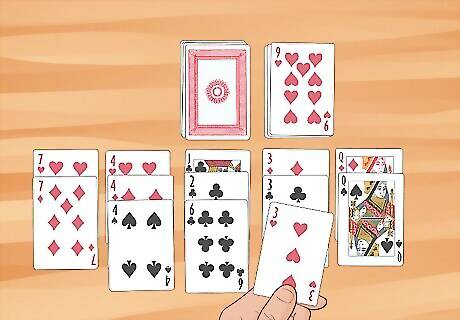
Poker fans will love this quick solo card game that’s easy to pick up. If you don’t play Poker, it’s helpful to understand how Poker hands are ranked before you play. The goal of the game is to build the 5 best Poker hands with the available cards. Deal out 5 cards face up in a row in front of you. Each of these cards represents a Poker hand. The rest of the cards make up the draw pile. Take the top card from the draw pile and place it face up. Decide which hand you want to add it to, and then place it on top of that pile overlapping the card below it. If you draw a card you can’t play with any hand, add it to a discard pile. Continue drawing cards and placing them in the hands until you have 5 cards in each. Remember, once a card is added to a hand, you can’t move it to another hand. When you have 5 hands of 5 cards each, tally up your score using the following points totals: Royal Flush - 10 points Straight Flush - 9 points 4 of a Kind - 8 points Full House - 7 points Flush - 6 points Straight - 5 points 3 of a Kind - 4 points 2 Pairs - 3 points Pair - 2 points High Card - 1 point
Freecell
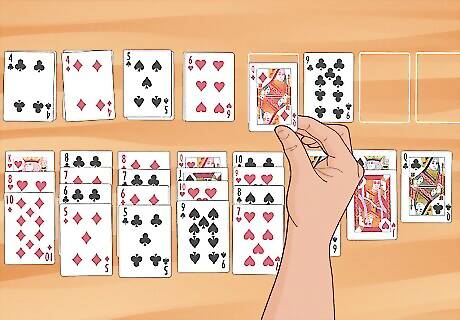
Freecell can be very challenging for beginner solo card game players. When you play Freecell, the goal is to make stacks of cards that descend sequentially from King to Ace for each of the 4 suits. Deal all of the cards face up into 8 piles, with each card overlapping the card above. Make stacks of 6 for half of the piles and stacks of 7 for the other half. Leave space above the cards for 4 foundations and 4 free cells. Place any available Aces in the foundation spaces. Only play cards at the bottom of each stack. Once you place a card on a foundation pile, you can’t move it back into play. Move cards from one column to another to free up cards by creating numerical runs with alternating colors. You must place cards in descending order by suit. For example, you can only place Hearts on the Ace of Hearts foundation. You may only move 1 card at a time. If you have open free cells, you can move a sequence of cards equal to the number of open free cells plus 1. For example, if you have a sequence of 4 cards in 1 row, you must have at least 3 open free cells to move that sequence to another column. If you clear a column, you can treat that space the same as a free cell.
Wish
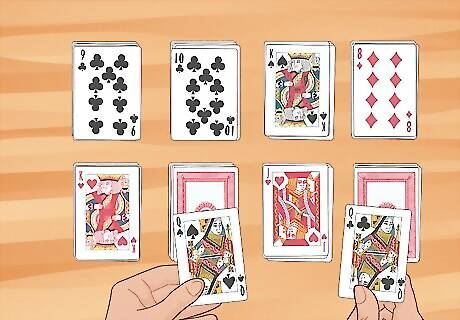
If you want something quick and easy, Wish is your game. It’s played with only 32 cards from a standard deck of playing cards and is a good choice for kids 8 years old and up. The goal is to clear away all of the piles by pairing cards by rank. Remove all 2s, 3s, 4s, 5, and 6s from the deck, and then shuffle. Deal 8 piles of 4 cards each, all face-down. Make a wish before flipping the top card of each pile. (This is how the game got its name, and it’s said to increase the odds of your wish coming true.) Match pairs of cards with matching ranks and then clear them from the game. Flip over the next card from each pile that had a card cleared in the previous round. Repeat until you clear all of the cards.
Golf Solitaire
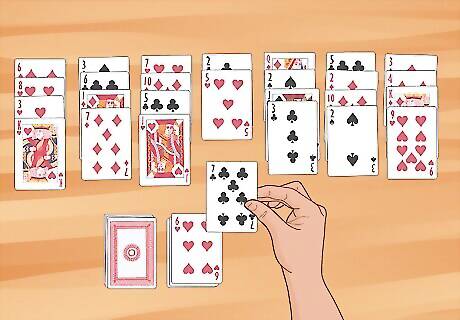
If you love golf, Golf Solitaire is perfect for rainy days at home. It’s another game that’s relatively easy to learn but harder to win. You play 9 rounds with the goal of earning the lowest score possible. Deal out 7 piles of 5 cards each, all face-up and overlapping the card above to create a column. Use the rest of the cards as your draw pile. Flip the top card of your draw pile and place it face up above the columns. This is your foundation. Build up or down on your foundation with cards from your columns. You may only use available cards at the bottom of the columns. Suit and color don’t matter as long as the card is 1 rank above or below the available foundation card. If you have a King at the end of the run, you can continue with an Ace and vice verse. You may not move cards from one column to another. When you are out of available moves, take another card from your draw pile. Place it face up on top of the foundation pile. This is your new foundation. Continue playing until you’ve moved all the cards to the foundation pile or you’ve used all of your draw pile. Tally your points. Each card is 1 point. If you have cleared all the cards, your score is zero. Play 9 total rounds and then add up the scores of for your final score.
Spider Solitaire
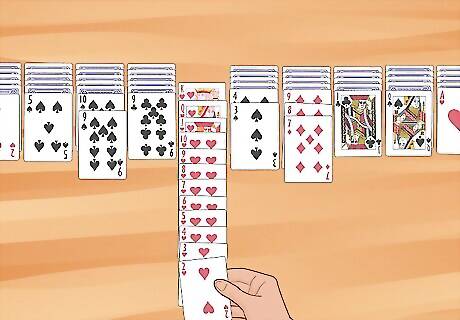
Spider Solitaire is the ideal game for players who want a challenge…sometimes. The goal is to build runs of cards from King to Ace to clear them from the game, but you can adjust the objective to make it easier to play. Shuffle the 2 decks together. Deal out a row of 4 piles of 6 cards and 6 piles of 5 cards. The rest of the cards are your draw pile. Flip the top card of each pile to face up. Move any card to another pile with an available card of 1 rank up in any suit. You can only move runs of cards together if they’re in the same suit in descending numerical order. When you remove the last face-up card from a pile, flip the next card to continue playing. After you have used the last card in a pile, you can use that space for any movable cards. Once you’ve built a run of cards in 1 suit from King to Ace, you can clear those cards from the game. You can move face-up cards to any empty column. If you have no available moves, place a card from your draw pile on each column and continue to play. When you run out of cards in your draw pile, the game is over, and you lose. If you are able to create King-to-Ace runs with all of your cards, you win. Make the game easier by creating sequential runs with cards of the same color instead of the same suit. For example, you can play spades and clubs together because they’re both black. You can play a still-challenging beginner version of Spider Solitaire by ignoring suit and color when building runs.
Beehive
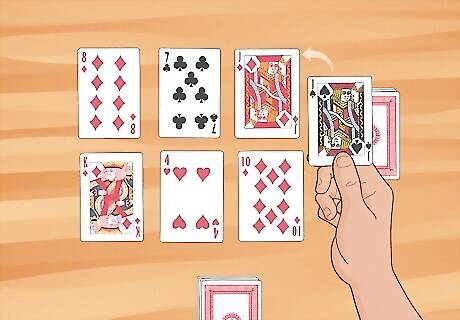
Beehive is great for kids or players who want an easy nature-themed game. The goal is to draw the bee cards to the flower garden by grouping them into sets of 4 of a kind. Deal 10 cards face down into a pile and flip the top card. This is your beehive. Deal another 6 cards face up into 2 rows of 3 cards each. This is the flower garden. Leave the leftover pile of cards face-down. This is your draw pile. If the top card of the beehive matches any cards in the flower garden, place it face up on top of that card. Flip the next beehive card. If 2 cards in the garden are the same value, move 1 of them on top of the other. When there is a space in the flower garden, move the top card in the beehive to that space. Once you’ve made all the available moves, take 3 cards from the draw pile and create a waste pile. If the top card on the waste pile matches any of the cards in the flower garden, move it to that pile and go to the next waste card. When you’re out of waste cards, take 3 more cards from the draw pile. Once you’ve created 4 of a kind in the flower garden, clear them from the game. Fill the empty space in the flower garden with a card from the beehive. If there are no more cards in the beehive, fill spaces in the flower garden with cards from your draw pile. You win the game by matching all the 4-of-a-kind cards in the deck. If you go through the draw pile without being able to make a move, you lose.
Accordion
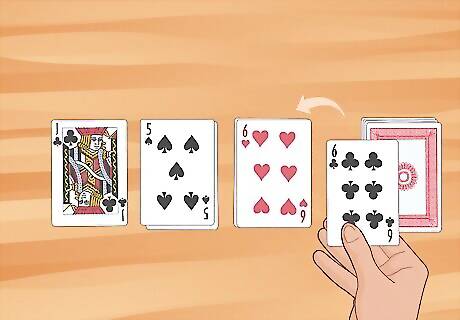
If you like to win, Accordion is your game, because it’s almost always solvable. The goal of the game is to move all of the cards into 1 pile by matching cards by suit or rank. After shuffling the deck, flip the top card and place it face up to your left. Flip the next card. If the flipped card is the same suit or rank as the previous card, place it on top. If the card doesn’t match the suit or rank, start a new pile next to the first card. Continue to flip cards from your draw pile and match them with existing piles or make new piles. You can match any card to the card immediately to the left or the third card to the left (but not the second) as long as they are the same suit or rank. When you move the top card of a pile, you must move the rest of the entire pile with it. Once you reach the last card in your draw pile, the game is over. If you’re able to move all of the cards into 1 pile, you win!
Bowling Solitaire
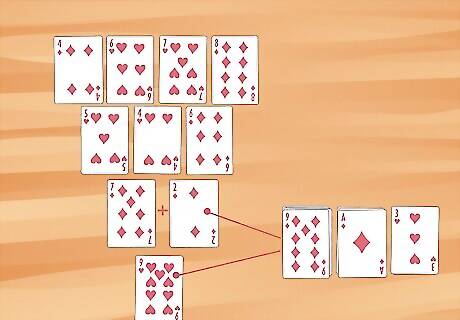
If you like bowling or playing longer card games, try Bowling Solitaire. However, it can be a little complicated to learn. Inspired by bowling, the object of the game is to “knock down” pin cards with ball cards, and can take up to 30 minutes to play. Sort out the Ace through 10 cards from 2 suits, one of each color. These are the only cards you need to play. Draw a bowling scorecard on a piece of paper consisting of a long horizontal rectangle divided into 10 smaller boxes. Use this sheet to keep your bowling score. Shuffle and then deal 10 cards face up in the shape of an inverted triangle with 4 cards in the top row and 1 card for the final row. These are the pins. To the side, deal 3 more piles face down. The first pile should have 5 cards, the second 3, and the last 2. Flip the top card from each pile. If one of the ball cards in the first pile has the same rank as a pin, it knocks that pin down. If the numbers on 2 pins add up to the number on the ball card, the ball knocks them both down. Once you knock down a pin, clear its card and the ball card from the game. Flip the next ball card in the first pile and check for eligible pins. You may not knock down a pin in the back row with the first ball. You can only knock down the middle pin after an adjacent pin has been knocked down. If you can’t knock pins down with any of your face-up ball cards, record the number of pins knocked down. Discard a face-up ball card from the first available pile. Continue to clear pins and discard ball cards. As long as you knock down a pin with a ball card, you’re on the same ball. Do not record your score until you discard a ball card. Reset the pin cards after each frame until you complete 10 frames.
Monte Carlo
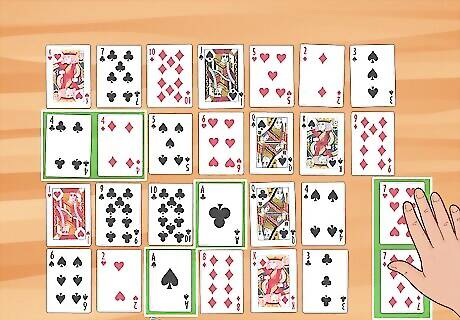
Play Monte Carlo if you want to take on Lady Luck. This game mostly depends on the luck of the draw to win, so it can be a little difficult. The goal is to move all of the cards to a foundation pile by matching pairs. Deal out 28 cards face up in 4 rows with 7 cards each. Use the rest of the cards as your draw pile. Move pairs that are adjacent or diagonal to each other to your foundation pile. When you’re out of moves, slide all the top cards to the left. Move cards up from the left side of the row below to fill spaces and repeat until all the cards are together at the top of your playing area. Fill the spaces in the rows at the bottom of your playing area with cards from your draw pile. Match pairs and refill the rows from your draw pile until you’re out of draw cards. You must clear all of the cards from the rows to win. Good luck!
Osmosis
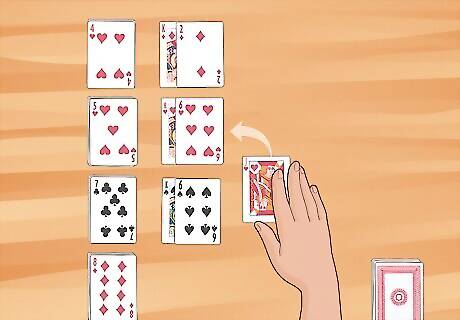
Give your brain a challenge by playing a few rounds of Osmosis. Once you get the hang of it, Osmosis is easy to play but hard to win. The goal is to sort cards into foundation piles based on the suit only. Deal 4 piles of 4 cards each with only the top card in each pile face up. These are your reserve piles. Deal 1 card face up next to the top reserve pile. This is the first foundation pile. Move any cards in the face-up reserve piles with a suit that matches the card in the foundation pile. When stacking cards, be sure to overlap the cards so you can see all of their ranks. The cards do not need to be in numerical order. When you move a reserve card, flip the next card in the pile face up. If you see any card that matches the rank of the first card in the foundation pile, you can start a new foundation pile to the right of the next reserve pile. You may only place cards in the lower 3 foundation piles that match the rank of a card in the first foundation pile. Once you’ve played all the possible face-up cards in the reserve piles, take 3 cards from your draw pile and lay them face up. You must play each card from the draw pile before the card under it. If you use all the cards in a reserve pile, place the next card from your draw pile in that space. When you reach the end of your draw pile, turn it over and start again by drawing 3 cards at a time. You win when you’ve sorted all the cards into your foundation piles!
Devil’s Grip
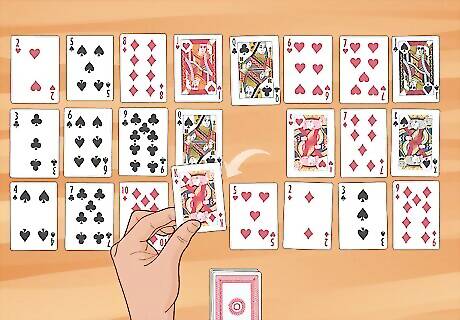
Devil’s Grip will keep you interested with extremely challenging gameplay. Play this game with 2 standard 52-card decks minus all 8 Aces, leaving a total of 96 cards. The object of the game is to stack all of the cards of the same suit in specific sequences based on the row they’re in. Deal 24 cards face up into 3 rows of 8 columns. Place the remaining cards face down in a pile. This is your draw pile. Scan the face-up cards and begin to build the following sequences for each row by piling cards that match the suit. Top Row: 2, 5, 8, J Middle Row: 3, 6, 9, Q Bottom Row: 4, 7, 10, K When you create a space by piling cards in the grid, fill it with a card from your draw pile. If there are no empty spaces and you can’t build any more sequences, flip the top 3 cards from the draw pile. You must play each card from the draw pile before the card under it. Continue to build sequences and draw cards until you can no longer make any moves. Total up the number of cards left in your draw pile. 6-10 cards - Good 3-5 cards - Excellent 2 or less - Brilliant
Aces Up
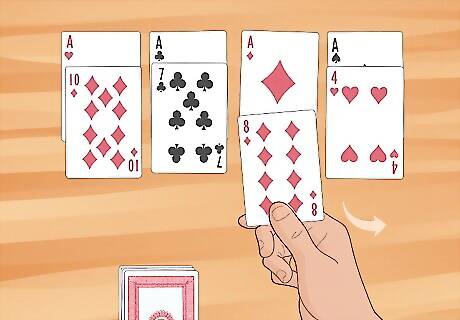
Aces Up is an easy game that’s perfect for traveling because it requires very little space. You play with the goal of moving all the cards to a foundation pile except for the 4 Aces. Deal 4 cards face up in a row. Pile the rest of the cards face down. This is your draw pile. Scan the 4 face-up cards for the same suit and move the lower of the 2 cards to the foundation pile. When there are 3 or more cards of the same suit, move all except the highest rank to the foundation pile. Ace Cards are the highest, followed by Kings, Queens, and Jacks. Refill any spaces in your row of 4 cards from the draw pile. When you run out of plays, deal 4 more cards face up on top of the current cards in your row. Only the top cards are playable. You may move the top card to an empty space to make the card below it available. Continue to play until you’ve depleted your draw pile and there are no more moves. Move all the cards to the foundation pile – except for the Aces – to win the game! You can also play alternate versions of Aces Up when you want to change things up.
Canfield
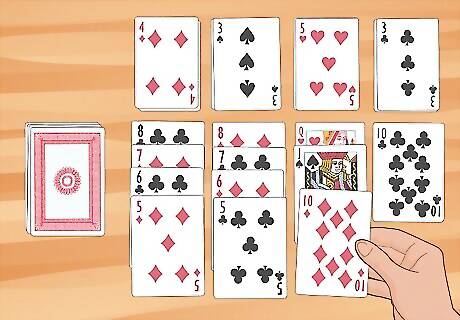
Test your skill with Canfield, a challenging game that’s hundreds of years old. Named after its inventor, Robert Canfield, the goal is to move all the cards to the 4 foundation piles. Deal 13 cards face down into a pile on your left and flip the top card face up. This is your reserve pile. Take the next card from the deck and place it face up in front of you. This is the first of 4 foundation piles. You may only start another foundation pile with a card that matches the rank of the first card in the first foundation pile. Deal 4 cards from the deck and place them face up in a row below the foundation pile. These cards make up your playable row. Set the remaining cards face down. This is your draw pile. You may move cards from the playable row to the foundation pile as long as they match the same suit and are 1 rank higher than the top card in the foundation pile. Kings are the highest-ranking cards, but you may stack an Ace on a King to continue the run. You may move a card to another pile in the playable row as long as it’s 1 rank lower and of the opposite color. You may move the top card of the reserve pile to the playable row or directly to one of the foundation piles. When there are no available moves, take 3 cards from your draw pile. You must play the top card first. Continue to play until all your cards have been moved to the foundation piles (a win) or you have no available moves (a loss).



















Comments
0 comment